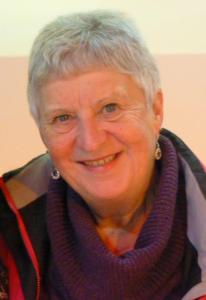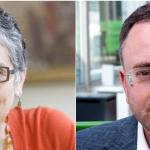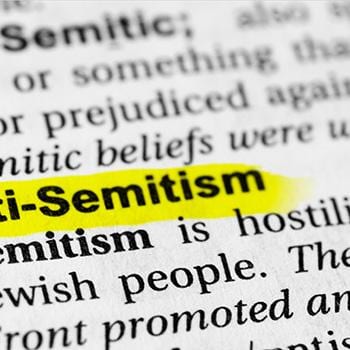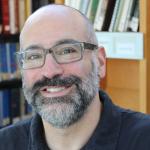If anyone tries to tell you that adopting the IHRA document on antisemitism does not stifle free speech, or prevent Palestinian solidarity, or wrongly accuse people of racism – then show them this case study. If you want to understand how Israel/Palestine eats away at an honest Jewish-Christian dialogue, then tell them what’s gone on at Southwell Minster in Nottinghamshire. If you worry that the meaning of antisemitism is being muddied and misused, then share the story of Jane Henson.
Sometimes it’s the small stories that tell you what’s really going on, the local incidents, unreported at a national level, which reveal the true dynamics of the debate over Palestinian human rights. When Jane Henson wrote a short reflection on her most recent visit to Israel and the West Bank for the Southwell Minster magazine, she had no idea of the storm that was coming her way. But come it did.
We can thank the Church of England’s hasty public endorsement of IHRA in September 2018 for what’s now taking place in the Diocese of Southwell and Nottingham and what will likely spread to many other parts of Anglican Church in the U.K. That’s unless the Church can get a whole lot better at understanding the difference between addressing antisemitism and colluding in the suppression of Palestinian rights.
Before we get to the detail of what Jane wrote and what then happened, there’s some important background to understand.
House of Bishops
The House of Bishops formally adopted the IHRA document without any of the usual detailed and lengthy debate that normally takes place before the Church of England makes changes to any aspect of its ways of working. It came in the wake of a long summer of mounting allegations of antisemitism directed against the Labour Party and specifically its leader, Jeremy Corbyn. By the autumn we were living in a political climate where adoption of the IHRA appeared to be the only acceptable way to show solidarity with the Jewish community in Britain.
Political parties, local government, trade unions, universities were all being asked by Jewish leaders to adopt the IHRA definition, and ideally its contentious examples too. Not adopting IHRA was starting to look like a position in itself. Why not? What’s wrong with it? What are you hiding?
You can imagine how the conversations went: If the leadership of the Jewish community is asking for its adoption, then we must go along with it. We can’t afford to be perceived as in anyway against it and therefore tolerant of antisemitism.
The House of Bishops formally endorsed IHRA two days after a meeting between the Archbishop of Canterbury, Justin Welby, and the British Chief Rabbi, Ephraim Mirvis at which Welby said:
“My feeling is, we as a Church need to adopt IHRA formally. I’m distressed that it should be necessary but I think it is necessary.”
It’s worth looking closely at the press release issued to announce the House of Bishop’s decision and at what else the Bishops wanted to say. It suggests there may be some tension within the Church of England’s hierarchy about how to approach the issue. Included in their statement was this call for everyone in public life to:
“…reject any language or actions which could cause prejudice, stigma or hatred towards people on the grounds of their religion, culture, origins, identity or beliefs.”
This was helpful additional commentary since the IHRA’s definition of antisemitism, despite being held up by the Board of Deputies of British Jews as a document fit for purpose and “internationally recognised”, is in fact remarkably weak, imprecise and confusing.
Here are the 39 words now presented as the gold standard for defining antisemitism:
“Antisemitism is a certain perception of Jews, which may be expressed as hatred toward Jews. Rhetorical and physical manifestations of antisemitism are directed toward Jewish or non-Jewish individuals and/or their property, toward Jewish community institutions and religious facilities.”
It’s weak because the IHRA sets the antisemitism bar at “hatred” which ignores the lived experience of most Jews and the most common expressions of antisemitism. Why go straight to “hatred” without mentioning prejudice, hostility or discrimination? Meanwhile, what does a “rhetorical manifestation” mean? And why complicate the wording with talk of antisemitism “directed at non-Jewish individuals”?
You have to ask how this definition adds anything to what’s already in the Oxford English Dictionary which explains antisemitism clearly and succinctly as “Hostility to or prejudice against Jews”.
So we should thank the Church of England for its additional commentary on the poorly worded paragraph it felt compelled to sign up to.
While the actual definition is weak and confusing, it’s been the eleven ‘examples of antisemitism’ put forward by the IHRA, seven of which refer directly to the State of Israel, which have caused the most controversy.
The examples and the definition are often merged together in mainstream reporting, and especially by leaders of the Jewish community, and other advocates for Israel, by using the phrase “full definition”, even though the IHRA clearly shows the definition and examples as separate texts.
The emphasis on Israel is why critics fear (myself included) that the promotion of the IHRA document is motivated by the wish to protect Israel and Zionism from criticism, rather than Jews from antisemitism. The “full definition” undoubtedly turns any recounting of the Palestinian experience of Zionism into an expression of antisemitism. Many of the countries and institutions who have adopted the IHRA definition have made clear that they have not adopted the illustrations too, including the UK Government and the European Parliament.
For a fuller account of the history and flaws of the IHRA document, and further links to legal criticism, I’d recommend Antony Lerman’s essay for Open Democracy published last September. Lerman is widely respected as an expert on European antisemitism.
Caveats
Often forgotten is the document’s own caveats concerning its proper use which appear before the eleven ‘examples’.
“Contemporary examples of antisemitism in public life, the media, schools, the workplace, and in the religious sphere could, taking into account the overall context, include, but are not limited to:” [my emphasis added]
The press statement issued by the Church of England also quoted the Bishop of Manchester, David Walker, who wanted to remind everyone that:
“… we will continue to speak out critically when governments here and elsewhere act in ways that our faith calls us to challenge.”
In other words, the Church wanted it to be known that: we know many of our parishioners and clergy at all levels are deeply concerned about what goes on in the Holy Land and we’re not going to throw them under a bus when they say critical things about Israel.
At least that appeared to be the theory. In practice, at a local level, it’s looking rather different.
Before we look at the article that’s now causing such controversy, let me tell you a little more about Jane.
Meet Jane Henson

Jane has more experience of life in the West Bank for Palestinians than most Anglicans or Jews living in the UK.
She and her husband John (a retired Anglican priest) made their first visit to see the Occupation up close in 2010 through a trip organised by Amos Trust. Amos has thirty years of experience in the region and has formed deep relationships with Christian and Jewish partners working on the ground for peace and justice. I should mention that I’ve been a trustee of the charity since 2016 and first met Jane in 2017 during the final days of the Amos Trust ‘Just Walk to Jerusalem’ to mark the Balfour Declaration centenary.
Jane describes that first visit she and John made as having “changed our lives completely”. She’s been back to Israel/Palestine every year since to help with the olive harvests in villages near Nablus where she’s witnessed “considerable interference and attacks from settlers”. Over the last few years, John has taken part in five house rebuilding projects helping local Palestinian families whose homes have been destroyed through the apartheid rules that govern land use and property rights in the West Bank.
In 2013 Jane and John were asked to volunteer at St. George’s Cathedral in East Jerusalem, the heart of Palestinian Anglicanism. An initial six-month commitment turned into two years. John helped-out by doing everything from taking services to cleaning the brasses while Jane worked as a personal assistant to the Cathedral Dean and later the Bishop. In Jane’s words it was “a very mixed experience but it enabled us to make many deep and lasting relationships”.
In the autumn of 2018 Jane returned to the West Bank with a small group of women friends to help with another olive harvest. They spent time in and around Bethlehem, Hebron, and the South Hebron Hills as well as in East and West Jerusalem. On Jane’s return she circulated her reflections to interested friends and was invited to publish an edited version for the Southwell Minster magazine. Jane and John had made Southwell Minster their worship home for many years. The magazine’s printed edition of a few hundred copies was published just before Christmas 2018.
In her article Jane describes picking olives around Bethlehem, observing the impact of the Separation Wall, visiting the Aida Refugee camp, and seeing Banksy’s Walled Off Hotel. On a visit to West Jerusalem, Jane and her friends joined the Women in Black, a group of Jewish women who’ve been standing silently every Friday for more than 30 years in protest at the injustice of the Occupation.
Jane goes on to describe a visit to Hebron and the daily humiliations for women crossing through the dozens of checkpoints in the area. She recounts hearing the shots that killed a father of seven at the checkpoint outside the Ibrahimi Mosque after he failed to understand an instruction given by an Israeli soldier. She sees first-hand the building restrictions which leave Bedouin families living in wretched conditions while their Jewish Settler neighbours have easy access to mains electricity and water. Jane writes:
“We spent time listening to people who, though deeply affected by the hardships and brutality around them retain hope and dignity.”
In East Jerusalem Jane joined Jewish Israelis protesting against the takeover of Palestinian homes in the city. Finally, she recalls a visit to the Holocaust Remembrance Centre, Yad Vashem. It was her third visit to the museum since 2010.
And then we come to the final paragraph in Jane’s article:
“As I studied the various memorials and testaments, I was not only struck again by the truly terrible events which had taken place in the last world war and the awful suffering of the Jews and others in the concentration camps, but also the awful realisation that so many of the things that were done to the Jews are now being done to the Palestinians. Listening to the guides telling the groups about such things as the walls which were built to keep the Jews in and away from friends and families and the fact that the Jews had to build the wall themselves, is exactly what is being done to the Palestinians now. The separation from their work, livelihood and families, the deprivation of water, electricity and inhumane treatment, including the imprisonment of children were all too painful for me. I had to withdraw, and all I could say, as I wept, was; ‘What have we learned, what have we learned?’. It was frightening to realise that most of the thousands who visit Yad Vashem are quite unaware of what is actually being inflicted on the Palestinians only a few miles away … or don’t care.” [My emphasis added]
Initial reaction from Jane’s fellow parishioners at the Minster was appreciative and understanding.
However, in the week after Christmas the complaints started to arrive.
I’ve seen two pieces of correspondence, both from Christian critics, complaining to the editor of the magazine, Hugh Middleton, and the Dean of the Minster, Nicola Sullivan. Since the letters have not been published I won’t give the names of the senders.
Both these complaints focus on the comparisons to Jewish persecution highlighted in the paragraph above.
“worst of all is Henson’s observation – after the visiting Israel’s National Holocaust Memorial – that ‘so many of the things that were done to the Jews [by Nazis] are now being done to the Palestinians’. As well as being completely untrue, it also contravenes the International Holocaust Remembrance Alliance Definition of antisemitism, adopted by the House of Bishops in 2018, which states that comparisons between the policies of the State of Israel and those of the Nazis constitute antisemitism.”
The writer of this letter, like many others, conflates the IHRA’s short description of antisemitism with the eleven ‘examples’ turning it all into one single definition. Disregarding the “could” and “overall context” caveats, the criticism leaves no room for debate and simply asserts that Jane’s words “constitute antisemitism”.
An email sent to Hugh Middleton described the article as “deeply anti-semitic” and “an appalling piece of Jew-baiting literature”.
This was followed by an article in the Jewish Telegraph (JT) newspaper under the headline: ‘Church magazine compares Israeli policy to the Nazis’. The JT article quotes Gideon Falter, Chairman of the Campaign Against Antisemitism, saying:
“the international definition of antisemitism is completely clear that drawing comparisons of contemporary Israeli policy to that of the Nazis’ is antisemitic.”
Falter goes on to describe Jane’s reflections as: “a shameful, historically illiterate article.”
Jane was also shown other correspondence from Jewish complainants which she described to me as “very vicious and nasty”.
The Dean received a letter from Council of Christians and Jews (CCJ) suggesting that it should help her with local training on antisemitism. CCJ also invited the Dean to go on a 10-day course at Yad Vashem for Church leaders this September, which Sullivan has agreed to.
Jane and Hugh Middleton then met with Nicola Sullivan who Jane described as “shocked” by the complaints and “obviously under pressure from the Bishop [the Right Reverend Paul Williams] to make a response”.
A response was composed and sent to those that had complained:
“The editorial team of Southwell Leaves magazine is very sorry that some of what appeared in an article ‘My reflections on a recent time in Palestine’ has been construed as antisemitism. This was not our intention and we apologise for any distress this has caused.”
In the apology letter, the Dean also promised the Minster would remove all further copies of the printed magazine and the article would not appear in the online edition but an apology would. In addition, antisemitism training for clergy and staff at the Minster would take place in July.
So was the article antisemitic?
There are good reasons not to make comparisons between Nazi behaviour and the behaviour of the State of Israel or individual Israelis. Such comparisons can be insensitive and imprecise. It can suggest that you’re referring to extermination camps rather than any other earlier Nazi policy or behaviour. There’s always a danger of minimising the scale and impact of the Holocaust by attempting to draw parallels with contemporary events.
The fact that Nazi comparisons nearly always seem to be made in relation to Israel, rather than against any other reprehensible government, is important to note. But this may have more to do with the profound historical connection between the Holocaust and the creation of the State of Israel which means the two events are forever entangled in the public imagination.
Certain words, in particular ‘concentration camps’ appear to have become exclusive property of the Nazis Holocaust and cannot be used in any other context without causing uproar, as U.S. Congresswoman Alexander Ocasio-Cortez discovered recently.
All in all, making Nazi comparisons is usually a bad idea which leads instantly to a row about antisemitism rather than a discussion about Palestinian rights – as Jane Henson’s story shows. But that doesn’t mean such comparisons automatically add up to antisemitism. And in the case of Jane’s article, such an accusation is without doubt unfair and fails to follow the IHRA guidance to consider the context.
Specific and universal
Jane’s article does not deny the Holocaust. Neither does it draw Israeli comparisons with the final evils of the Holocaust which we now sum up in one word – ‘Auschwitz’. Jane is both highly specific and highly universal in how she makes her references to the Nazi period of German history.
It’s perfectly clear in the article that Jane is not thinking of extermination camps when she reflects on her experience. She specifically talks of “walls” keeping individuals away from “friends and family”; taking away peoples’ “livelihoods”; and the “imprisonment of children”. All of these examples have parallels to the treatment of Jews by the Nazis.
No doubt, advocates for Israel will insist that the circumstances of Palestinians today and those of the Jews in Europe in the 1930s and 40s are entirely different and no comparison is justified. This is about security concerns not race, they will argue. But can either explanation ever justify such treatment? Even if the comparison is not an exact match, does making the comparison really amount to antisemitism? And because the crimes being committed against Palestinians are not mass murder on an industrial scale does that mean there is no place for compassion and even outrage?
But we still haven’t considered the most important piece of context for Jane’s article – Yad Vashem itself.
Jane’s comparison to what happened to Jews in Europe is neither random nor deliberately provocative. When Jane stands at Yad Vashem and weeps, the physical location is paramount to understanding her reflections as well as judging her motivations.
Jane is walking through the museum’s exhibition halls reflecting on what she has seen happening to Palestinians just a few miles from where she now stands. She makes inevitable and perfectly understandable connections about the nature of the human condition based on her most recent experience. Jane’s tears are for humanity’s immense capacity for cruelty and for our collective failure to change our behaviour: “What have we learned, what have we learned?”. Jane’s accusatory question is not directed at Israel, or Israelis, or Jews collectively. It’s very clearly addressed to every one of us.
I don’t see Jane’s words as “constituting antisemitism”, not even of the mild variety caused by lack of knowledge. I certainly don’t see “Jew-baiting”. And if the Chairman of Campaign Against Antisemitism sees only “a shameful, historically illiterate article” he is a poor literary critic and an even worse ethicist.
But Jane’s critics have had no interest in applying rational or dispassionate thinking. As for examining the relevant context, that has been completely absent.
Meanwhile, the criticism against Jane was about to ramp up.
A second apology
Through January and February, the complaints and correspondence continued and the Dean, Nicola Sullivan, was being advised by the Council of Christians and Jews and a Church of England interfaith initiative called Presence and Engagement to strengthen her apology.
It was not enough to say that that Jane’s reflections could be “construed as antisemitism”. The Church had to accept that is was antisemitism and there was no room for the slightest doubt.
The second apology was issued on 13 March 2019
STATEMENT FROM THE DEAN OF SOUTHWELL
The December 2018/January 2019 printed edition of Southwell Leaves magazine included an article which in reflecting on the suffering of Palestinians used antisemitic language.
As Dean I apologise unreservedly. Mindful of the ways in which Christians have contributed to antisemitism throughout history, the Cathedral condemns antisemitism, recognising the pain and fear it causes the Jewish community. I have accepted the offer from the Council of Christians and Jews to deliver training on antisemitism to relevant Cathedral staff and volunteers and so enable a clearer understanding which addresses and prevents antisemitism.
The Cathedral values its partnership with the Anglican diocese of Jerusalem and St. George’s Cathedral, and we will continue to work and pray for peace and justice in Israel/Palestine, but always within the parameters of respect for all people.
The Very Revd Nicola Sullivan
Demonstrating contrition
Jane was deeply upset when she saw the new apology from the Dean.
“Never at any point in the two meetings which I had had with her had there been any inference that I had used antisemitic language, just that others had found some of what I had said antisemitic.”
Jane’s article had now become firmly placed in a context of historical Christian antisemitism. This had become the dominant narrative around its publication. The Church has failed on antisemitism (again). The Church had to apologise (again). Defending the article on grounds of fair comment or free speech was clearly not an option. Protecting its parishioner had also become out of the question. The Church had to demonstrate its contrition.
Jane had not been involved or consulted in the wording of the second apology. Nor had there been any discussion of her simply amending her article before it appeared online.
The hyper-alertness and hyper-sensitivity to the slightest possibility of antisemitism was matched only by a dullness in sensitivity regarding the on-going, daily persecution of Palestinians.
Jane told me she was “devastated by what had and was happening”.
To try and understand what was happening, and why, Jane contacted Kat Brealey, the national programme co-ordinator for ‘Presence and Engagement’. As part of her work, Brealey is in close contact with the Council of Christians and Jews and the Board of Deputies. It became clear in Jane’s conversation with Brealey that the drafting of the second apology had directly involved the CCJ and the Board. Brealey sympathised with the plight of Palestinians and recognised that there were Jewish groups in Israel, America and the U.K. who advocated for them. But her primary concern in this whole affair was to ensure that the Church did not give British Jews any cause to call the Church antisemitic.
The state of Jewish-Christian dialogue
What this case study illustrates is the ease with which Christian witness to the widespread injustices being suffered by Palestinians is set aside as secondary, and even inconsequential, compared to the weakest of antisemitism claims. The Church of England hierarchy is unwilling to challenge the narrative framework it has co-created and ends up censoring itself and colluding in the suppression of Palestinian advocacy. This all takes place in a belief that good Jewish-Christian dialogue is being maintained because the Church is listening and acting on Jewish concerns. But that’s to misunderstand what ‘good’ should look like and to ignore what’s missing from the conversation.
Where is the interfaith exploration of what the Holocaust and the creation of the State of Israel means historically, theologically, politically and ethically for Jews and for Christians? The questions raised by these two monumental events of the 20th century are complex, multilayered and interconnected. And they certainly can’t be addressed without reference to the Palestinian people, their displacement and on-going oppression.
There appears to be little attempt to navigate this territory using shared scriptural commitments to justice and a shared understanding of the equality of all humanity in the eyes of God. Instead, Jewish-Christian dialogue is reduced to training courses on antisemitism build around the flawed and politically motivated IHRA “full definition”.
Apologies and Education
Over the last few months there’s been much talk of apologies and the need for education. But are the right apologies being made and the right lessons being learnt?
The House of Bishops should apologise for failing to uphold its own commitments to “speak out critically when governments here and elsewhere act in ways that our faith calls us to challenge injustice.”
The Dean of Southwell Minster should apologise for characterising Jane Henson’s article as antisemitic.
The Council of Christians and Jews and the Presence and Engagement programme should apologise for colluding in the suppression of Palestinian advocacy.
And all should apologise for failing to apply context and common sense to what’s taken place at Southwell Minster.
As for education, it’s certainly needed. Education on international law and human rights. Education on free speech. Education on the history of Zionism as experienced by Palestinians over the last 100 years.
Jane doesn’t feel she can continue to worship at Southwell Minster after what’s taken place. Nor can she face the idea of attending the antisemitism training being run in July knowing that it’s her article that’s the cause for it taking place. Jane told me it’s now easier to speak to her non-Christian friends about her Christian commitment to Palestine than it is to talk about it when she goes to church.
The IHRA document turns out to be an unhelpful tool for dialogue in the context of Israel/Palestine – as many of us had feared it would be. As this story has shown, it’s far more likely to be used as a blunt instrument to stifle relevant conversations and meaningful reconciliation. We would all be a lot better off without it.
Please share this article with those in positions of leadership in the Church of England, and other Christian denominations.













